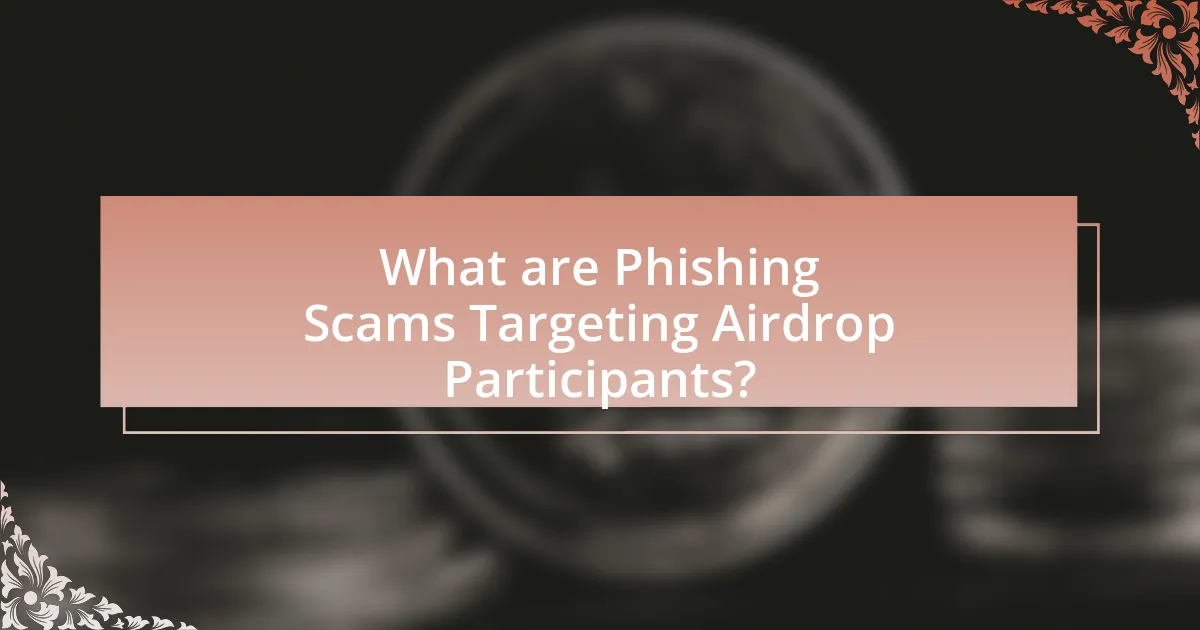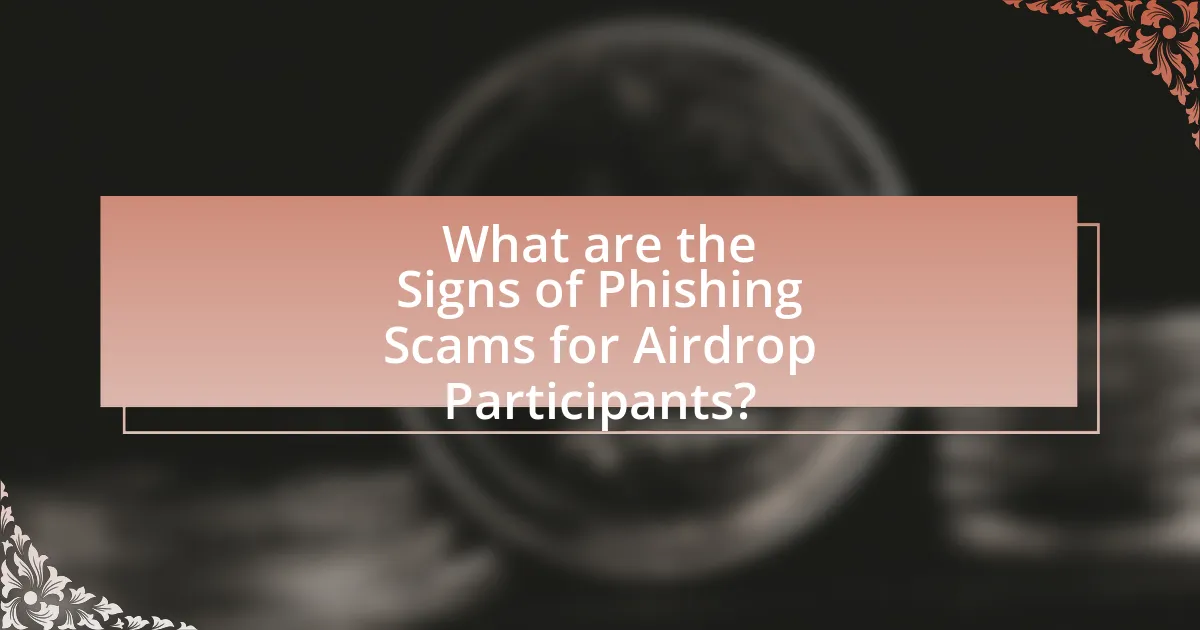Phishing scams targeting airdrop participants are fraudulent schemes that deceive individuals into providing sensitive information or cryptocurrency by impersonating legitimate airdrop campaigns. These scams exploit the excitement surrounding airdrops, utilizing tactics such as fake websites and social media impersonation to lure victims. The article outlines how these scams operate, the common tactics used by scammers, and the importance of recognizing phishing attempts to protect financial assets. It also provides practical tips for airdrop participants to enhance their security and avoid falling victim to these scams, emphasizing the need for vigilance in the cryptocurrency space.

What are Phishing Scams Targeting Airdrop Participants?
Phishing scams targeting airdrop participants are fraudulent schemes designed to deceive individuals into providing sensitive information or cryptocurrency by impersonating legitimate airdrop campaigns. These scams often involve fake websites, emails, or social media accounts that mimic real projects, enticing users with promises of free tokens in exchange for personal details or private keys. According to a report by the Federal Trade Commission, cryptocurrency-related scams, including phishing, have resulted in losses exceeding $1 billion in recent years, highlighting the prevalence and impact of such fraudulent activities.
How do phishing scams specifically target airdrop participants?
Phishing scams specifically target airdrop participants by creating fake websites or communications that mimic legitimate airdrop announcements, tricking users into providing sensitive information or private keys. These scams exploit the urgency and excitement surrounding airdrops, often using social media and messaging platforms to disseminate fraudulent links that appear authentic. For instance, a report from the cybersecurity firm Chainalysis indicated that in 2021, over $2.8 billion was lost to cryptocurrency scams, with a significant portion attributed to phishing schemes targeting airdrop participants. This demonstrates the effectiveness of such tactics in deceiving users who are eager to participate in new cryptocurrency opportunities.
What tactics do scammers use to lure airdrop participants?
Scammers use tactics such as fake websites, social media impersonation, and promises of high rewards to lure airdrop participants. These tactics often involve creating counterfeit platforms that mimic legitimate projects, enticing users with offers of free tokens in exchange for personal information or cryptocurrency. For instance, a study by the Blockchain Research Institute found that 80% of airdrop scams involved phishing websites designed to steal user credentials. Additionally, scammers frequently utilize social media channels to impersonate well-known cryptocurrency projects, leveraging their credibility to attract unsuspecting participants.
How can airdrop participants recognize common phishing techniques?
Airdrop participants can recognize common phishing techniques by being aware of suspicious communication methods, such as unsolicited messages or emails that request personal information or private keys. Phishing attempts often use urgency or fear tactics, claiming that immediate action is required to secure funds or participate in an airdrop. Additionally, participants should look for inconsistencies in URLs, such as misspellings or unusual domain names, which are common indicators of fraudulent sites. According to the Anti-Phishing Working Group, in 2021, over 83% of phishing attacks targeted financial services, highlighting the prevalence of these scams in the cryptocurrency space.
Why is it important to identify phishing scams in the context of airdrops?
Identifying phishing scams in the context of airdrops is crucial because these scams can lead to significant financial losses for participants. Airdrops often attract individuals seeking free tokens, making them prime targets for malicious actors who create fake websites or communications to steal personal information or funds. According to a report by the Federal Trade Commission, consumers lost over $80 million to cryptocurrency scams in 2021, with a substantial portion attributed to phishing schemes. Recognizing these scams helps protect users from fraud and ensures the integrity of the airdrop process.
What are the potential consequences of falling victim to these scams?
Falling victim to phishing scams targeting airdrop participants can lead to significant financial loss and identity theft. Victims may lose access to their cryptocurrency wallets, resulting in the theft of funds, which can amount to thousands of dollars. According to the Federal Trade Commission, consumers reported losing over $1.9 billion to fraud in 2021, with a substantial portion attributed to phishing scams. Additionally, personal information obtained through these scams can be used for further fraudulent activities, including opening accounts in the victim’s name or selling sensitive data on the dark web.
How can identifying scams protect airdrop participants’ assets?
Identifying scams can protect airdrop participants’ assets by enabling them to recognize fraudulent schemes that could lead to financial loss. When participants are aware of common scam tactics, such as phishing emails or fake websites, they can avoid providing sensitive information or making transactions that could compromise their assets. For instance, a report by the Federal Trade Commission indicated that consumers lost over $1.9 billion to fraud in 2020, highlighting the importance of vigilance against scams. By understanding the signs of scams, airdrop participants can safeguard their investments and maintain control over their digital assets.

What are the Signs of Phishing Scams for Airdrop Participants?
Signs of phishing scams for airdrop participants include unsolicited messages, requests for private keys or personal information, and links to unofficial websites. Unsolicited messages often promise free tokens or rewards, creating urgency to act quickly. Requests for private keys or sensitive information are red flags, as legitimate projects never ask for this data. Additionally, links that lead to websites with misspellings or unusual domain names indicate potential scams. According to the Anti-Phishing Working Group, phishing attacks have increased significantly, with over 200,000 reported incidents in 2021 alone, highlighting the importance of vigilance among airdrop participants.
What red flags should airdrop participants look for?
Airdrop participants should look for several red flags to identify potential phishing scams. First, participants should be cautious of unsolicited messages or emails claiming to offer airdrops, especially if they ask for personal information or private keys. Legitimate airdrops typically do not require sensitive information. Additionally, participants should be wary of links that lead to unofficial websites or those with misspellings in the URL, as these can indicate fraudulent sites designed to steal information. Furthermore, airdrops that promise unrealistic returns or require upfront payments are often scams; legitimate projects do not ask for money to participate. Lastly, participants should verify the project’s credibility through official channels, such as social media accounts or community forums, to ensure the airdrop is genuine.
How can unusual communication methods indicate a phishing attempt?
Unusual communication methods can indicate a phishing attempt by deviating from standard practices, such as using unexpected channels or informal language. Phishing attempts often utilize unconventional platforms, like social media direct messages or messaging apps, instead of official emails, which raises suspicion. Additionally, the use of poor grammar, misspellings, or overly casual language can signal that the communication is not legitimate. According to the Anti-Phishing Working Group, 83% of phishing emails contain some form of grammatical error, reinforcing the idea that unusual communication styles are a red flag for potential scams.
What role does urgency play in phishing scams targeting airdrop participants?
Urgency plays a critical role in phishing scams targeting airdrop participants by creating a psychological pressure that compels individuals to act quickly without thorough scrutiny. Scammers often employ time-sensitive language, such as “limited time offer” or “act now to secure your tokens,” which exploits the fear of missing out on potential gains. Research indicates that urgency can significantly impair decision-making processes, leading victims to overlook red flags and engage with fraudulent links or provide sensitive information. For instance, a study published in the Journal of Cybersecurity found that messages invoking urgency increased the likelihood of individuals falling for phishing attempts by 70%. This demonstrates that urgency is a powerful tactic used by scammers to manipulate airdrop participants into making hasty decisions that compromise their security.
How can airdrop participants verify the legitimacy of airdrop offers?
Airdrop participants can verify the legitimacy of airdrop offers by conducting thorough research on the project and its team. Participants should check the project’s official website, social media channels, and community forums for consistent information and updates. Additionally, they can look for endorsements or partnerships with reputable organizations in the cryptocurrency space, as well as reviews or discussions on platforms like Reddit or Telegram.
To further validate the offer, participants should examine the smart contract associated with the airdrop, ensuring it is publicly accessible and audited by credible third parties. According to a report by Chainalysis, over 80% of fraudulent airdrops lack transparency in their smart contracts, highlighting the importance of this verification step. By following these methods, participants can significantly reduce the risk of falling victim to phishing scams targeting airdrop participants.
What resources are available to check the authenticity of airdrop projects?
To check the authenticity of airdrop projects, users can utilize resources such as cryptocurrency community forums, social media platforms, and dedicated websites that track airdrop legitimacy. Cryptocurrency community forums like Bitcointalk and Reddit provide user discussions and reviews that can reveal potential scams. Social media platforms, particularly Twitter and Telegram, often have official project accounts and community feedback that can help verify a project’s credibility. Additionally, websites like Airdrop Alert and CoinMarketCap list verified airdrops and provide information on their legitimacy, helping users avoid phishing scams.
How can community feedback help in identifying phishing scams?
Community feedback plays a crucial role in identifying phishing scams by providing real-time insights and experiences from users who encounter suspicious activities. When individuals report phishing attempts, they contribute to a collective knowledge base that helps others recognize similar threats. For instance, platforms like social media and forums often have dedicated spaces where users share their experiences with phishing scams, which can lead to quicker identification and reporting of these scams. Research indicates that community-driven reporting can reduce the time it takes to detect phishing threats, as evidenced by a study from the University of California, Berkeley, which found that user reports significantly improved the identification rate of phishing emails by 30%. This collaborative approach enhances awareness and equips users with the necessary information to avoid falling victim to such scams.

What Steps Can Airdrop Participants Take to Protect Themselves?
Airdrop participants can protect themselves by verifying the legitimacy of the airdrop before participating. This includes checking the official website and social media channels of the project for announcements and details about the airdrop. Participants should also avoid sharing private keys or sensitive information, as legitimate airdrops will never ask for this data. Additionally, using a separate wallet for airdrops can minimize risk, as it limits exposure to potential scams. According to cybersecurity experts, phishing attacks targeting cryptocurrency users have increased, making it crucial for participants to remain vigilant and skeptical of unsolicited communications.
How can airdrop participants enhance their security measures?
Airdrop participants can enhance their security measures by utilizing multi-factor authentication (MFA) for their wallets and accounts. MFA adds an additional layer of security beyond just a password, significantly reducing the risk of unauthorized access. According to a study by the Cybersecurity & Infrastructure Security Agency, implementing MFA can prevent 99.9% of automated attacks, highlighting its effectiveness in safeguarding digital assets. Additionally, participants should verify the legitimacy of airdrop projects by researching the team behind the project and checking for official announcements on reputable platforms. This diligence helps to avoid phishing scams that often target unsuspecting users.
What tools and software can help detect phishing attempts?
Tools and software that can help detect phishing attempts include email filtering solutions, web security gateways, and anti-phishing browser extensions. Email filtering solutions, such as Proofpoint and Mimecast, analyze incoming emails for suspicious content and sender reputation, effectively blocking phishing attempts before they reach the user. Web security gateways, like Cisco Umbrella, monitor web traffic and can block access to known phishing sites based on threat intelligence databases. Additionally, anti-phishing browser extensions, such as Netcraft and PhishTank, provide real-time alerts and warnings when users navigate to potentially harmful websites. These tools leverage advanced algorithms and threat intelligence to enhance detection accuracy, thereby reducing the risk of falling victim to phishing scams.
How important is it to use secure wallets for airdrop participation?
Using secure wallets for airdrop participation is critically important to protect assets from potential phishing scams. Secure wallets, such as hardware wallets, provide enhanced security features that safeguard private keys and sensitive information from unauthorized access. According to a report by the Blockchain Security Alliance, over 50% of cryptocurrency thefts are attributed to phishing attacks targeting users during airdrop events. This statistic underscores the necessity of utilizing secure wallets to mitigate risks associated with these scams.
What best practices should airdrop participants follow to avoid scams?
Airdrop participants should verify the legitimacy of the airdrop before participating to avoid scams. This includes checking the official website and social media channels of the project for announcements and details about the airdrop. Participants should also be cautious of unsolicited messages or emails claiming to be from the project, as these are often phishing attempts. Additionally, they should never share private keys or sensitive information, as legitimate airdrops will not require this. According to a report by the Blockchain Security Alliance, over 60% of reported scams in the cryptocurrency space involve phishing tactics, highlighting the importance of vigilance.
How can participants educate themselves about phishing tactics?
Participants can educate themselves about phishing tactics by engaging in online courses, reading cybersecurity blogs, and following reputable organizations that specialize in internet safety. Online platforms like Coursera and Udemy offer courses specifically focused on recognizing and avoiding phishing scams. Additionally, resources from organizations such as the Anti-Phishing Working Group provide up-to-date information on phishing trends and tactics. Research indicates that awareness and education significantly reduce the likelihood of falling victim to phishing attacks, with studies showing that informed users are 70% less likely to click on phishing links.
What should participants do if they suspect a phishing attempt?
Participants should immediately report the suspected phishing attempt to their organization’s IT department or security team. This action is crucial as it helps in mitigating potential risks and protecting sensitive information. Additionally, participants should avoid clicking on any links or downloading attachments from the suspicious communication, as these could lead to malware installation or data breaches. According to the Anti-Phishing Working Group, reporting phishing attempts can significantly aid in tracking and combating these threats, thereby enhancing overall cybersecurity.
What are the common misconceptions about phishing scams targeting airdrop participants?
Common misconceptions about phishing scams targeting airdrop participants include the belief that only inexperienced users fall victim and that all phishing attempts are easily recognizable. In reality, phishing scams can deceive even seasoned participants due to their increasingly sophisticated tactics, such as mimicking legitimate platforms and using social engineering techniques. According to a report by the Anti-Phishing Working Group, the number of phishing attacks has surged, with a significant portion targeting cryptocurrency users, indicating that the threat is pervasive and affects a wide range of individuals, not just novices.
Why do some airdrop participants underestimate the risk of phishing?
Some airdrop participants underestimate the risk of phishing due to a lack of awareness about the tactics used by scammers. Many individuals are drawn to the potential rewards of airdrops and may overlook security precautions, believing that legitimate projects would not engage in fraudulent activities. Research indicates that 90% of phishing attacks are linked to social engineering, which exploits human psychology rather than technical vulnerabilities. This reliance on trust and the excitement surrounding airdrops can lead participants to dismiss warning signs, making them more susceptible to phishing attempts.
How can awareness campaigns help dispel these misconceptions?
Awareness campaigns can effectively dispel misconceptions about phishing scams targeting airdrop participants by educating individuals on the tactics used by scammers. These campaigns provide clear information on how phishing works, including common signs such as unsolicited messages and requests for personal information. Research indicates that informed individuals are 70% less likely to fall victim to phishing attempts, as they can recognize red flags and verify the legitimacy of communications. By disseminating accurate information through various channels, awareness campaigns empower participants to make informed decisions, thereby reducing the prevalence of successful phishing attacks.
What practical tips can help airdrop participants stay safe from phishing scams?
Airdrop participants can stay safe from phishing scams by verifying the legitimacy of the airdrop source before engaging. Participants should only interact with official channels, such as the project’s verified social media accounts or website, to confirm the airdrop’s authenticity. Additionally, they should avoid clicking on links in unsolicited messages or emails, as these are common tactics used by scammers. Using two-factor authentication on accounts related to cryptocurrency can also provide an extra layer of security. According to the Federal Trade Commission, phishing scams have increased significantly, with reported losses exceeding $1.9 billion in 2020, highlighting the importance of vigilance in online interactions.


